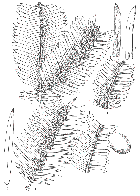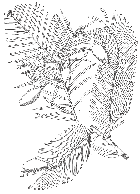
Line drawing; for full size image go to the Flora of China (Fu et al. 1999).

Another line drawing; for full size image go to the Flora of China (Fu et al. 1999).

Line drawing; for full size image go to the Flora of China (Fu et al. 1999).

Another line drawing; for full size image go to the Flora of China (Fu et al. 1999).
Cephalotaxus mannii
西双版纳粗榧 hai nan cu fei [Chinese] (Fu et al. 1999).
Fu et al. (1999) place it in synonymy with C. griffithii J.D. Hooker and C. hainanensis H. L. Li, but those taxa are here retained in accordance with the "World Checklist" of Farjon (1998). This creates a bit of a predicament because the only detailed desciption of the taxon that I have been able to locate is that by Fu et al. (1999), presented below. The three taxa may be distinguished in the wild, though, according to where they are found; C. hainanensis is, naturally, confined to the isle of Hainan, while the other two, more wide-ranging species also have disjunct distributions.
Trees to 20 m tall and 50(-110) cm dbh. Bark light brown to reddish brown, flaking off. Twigs elliptic or oblong-elliptic in outline, 8-19(-24) × 4.5-8(-9.5) cm, about 1/2 as wide as long. Leaves borne at 45-80° to branchlet axis; petiole ± absent or (0.3-)0.5(-1) mm; blade dark green or shining olive green adaxially, linear or linear-lanceolate, usually straight, occasionally slightly falcate, flat, 1.5-4 cm × 2.5-4 mm, leathery or relatively thin, midvein prominent adaxially, 0.2-0.3 mm wide abaxially, stomatal bands white or bluish white, often indistinct and green when dry because of white powder being shed, 0.7-1.6 mm wide, of 19-23(-26) rows of stomata, 2.5-8 × as wide as midvein, marginal bands 0.1-0.3 mm wide, base very broadly obtuse or obtusely truncate, symmetric or not, margin narrowly revolute, apex cuspidate (with leaf tapered into apex from at least middle, often from base), or abruptly and very shortly mucronate (with leaf parallel-sided and mucro 0.1-0.2 mm). Pollen cones borne 6-8 together, pale yellow, globose, 4-4.5 mm in diam.; peduncle (1-)4-5 mm, usually with at least 10 bracts; microsporophylls 7-13, each with 3 or 4 pollen sacs. Seed cones solitary or borne 2 or 3 together; peduncle 6-10 mm. Aril green initially, turning red when ripe, 2.2-3 × 1.1-1.2 cm. Seeds obovoid-ellipsoid or obovoid, sometimes laterally compressed, 2.2-2.8 cm, apex shortly mucronate or cuspidate. Pollination (November-)February-March, seed maturity August-October. 2n = 24 (Fu et al. 1999).
China: SW Guangdong (Xinyi Xian), Guangxi (Rong Xian), Hainan (Jianfeng Ling, Limu Ling, Wuzhi Shan), SE Xizang [Tibet], S and W Yunnan; NE India (Khasi, Jaintia and Naga Hills), Laos, N Myanmar, N Thailand, N Vietnam (Lam Dong, at altitudes above 950 m) (FIPI 1996 [as C. oliveri], Farjon 1998, Fu et al. 1999). According to Fu et al. (1999), "records of Cephalotaxus mannii from Xizang and Yunnan require confirmation; they may be misidentifications of C. fortunei var. alpina."
In China it grows in mixed forests and forested ravines at ca. 1100 m elevation (Fu et al. 1999). In Vietnam it grows in subtropical broad-leaved evergreen forest. Shade tolerant when young, intolerant when mature. Very low rates of natural regeneration. Suitable on many kinds of soil (FIPI 1996 [as C. oliveri]). Not cultivated in the U.S. (Tripp 1995). Hardy to Zone 9 (cold hardiness limit between -6.6°C and -1.1°C) (Bannister and Neuner 2001).
An endangered species in China (Fu et al. 1999), and listed as threatened in Viet Nam by the WCMC (2001). Sparsely distributed, and endangered by harvesting for timber and medicinal purposes throughout its range (Tripp 1995).
No data as of 2023.02.23.
The timber is straight-grained with fine structure and high elasticity, rather hard, easy to work, not splitting and deforming after seasoning, and resistant to termites and insects. It is used for high quality furniture, tool handles and fine art articles. Oil from the seeds is used in painting; the seed is also used in medicine (FIPI 1996 [as C. oliveri]).
No data as of 2023.02.23.
[WCMC] World Conservation Monitoring Centre. The Socialist Republic of Viet Nam Appendix 5 - Threatened Plant Species. http://www.wcmc.org.uk/infoserv/countryp/vietnam/app5.html, accessed 2001.11.25, now defunct.
The species account at Threatened Conifers of the World.
Last Modified 2023-02-26